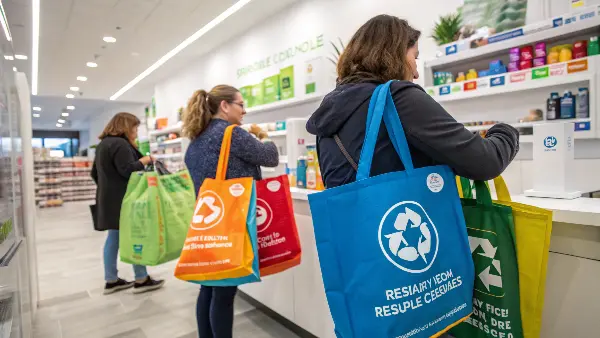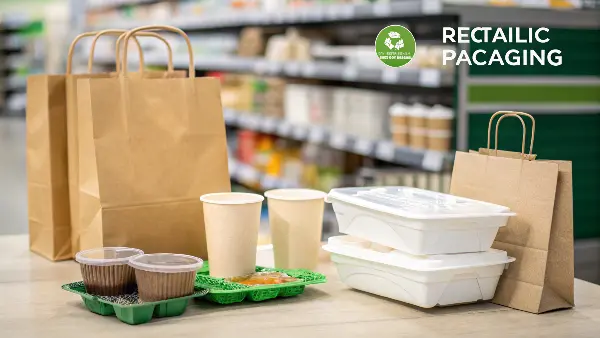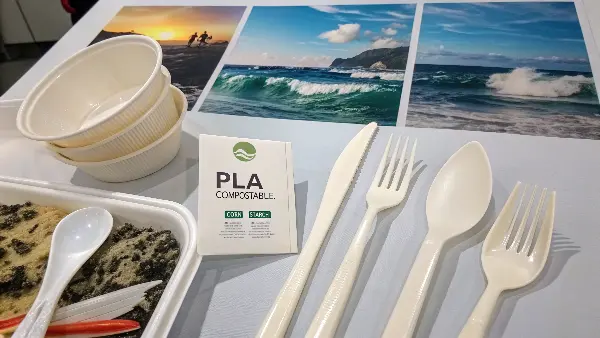Confused about choosing the right eco-products for your business? Wrong choices waste money and damage your reputation. Let’s focus on what truly works for sustainability and meets customer demands.
To choose the best eco-products for 2025, focus on items made from certified sustainable materials like bagasse, PLA, or FSC paper. Prioritize products meeting key standards (e.g., BPI, EN13432, FDA) and partner with suppliers who understand compliance, customization, and reliable global logistics for real impact.
That provides a general guideline. But which specific product categories are showing the most promise and offer the best potential for businesses aiming for sustainability in the coming year? Let’s dive into some key areas we’re seeing grow rapidly at Ecosourcecn.
Are Compostable Food Containers the Future for Food Service Businesses?
Worried about the mountain of single-use plastic waste from takeout and food service? Customers are demanding better, and regulations are tightening. Compostable containers offer a practical, green solution.
Yes, compostable food containers, particularly those made from materials like bagasse (sugarcane pulp) or PLA (polylactic acid), represent a significant part of the future for food service. They reduce reliance on fossil fuels, meet consumer expectations for sustainability, and decompose under specific conditions.
Let’s explore why these containers are becoming so essential for businesses like restaurants, cafes, and catering companies. The shift away from traditional plastic is undeniable, driven by both consumer pressure and increasing legislation worldwide targeting single-use plastics. Businesses need viable alternatives that don’t compromise on function.
Material Focus: Bagasse vs. PLA
Bagasse containers are made from the fibrous residue left after sugarcane processing. This makes them a fantastic example of utilizing an agricultural byproduct. They are sturdy, often microwave-safe, and handle hot and cold foods well. PLA containers are derived from plant starches, usually corn. They typically look more like traditional clear plastic, making them great for cold food visibility (like salads or desserts). PLA generally has lower heat tolerance than bagasse unless it’s modified (CPLA).
Key Benefits for Food Service
The primary benefit is environmental. Both materials are renewable and commercially compostable, breaking down significantly faster than conventional plastic in the right facilities. This helps divert waste from landfills. Using these products also strongly signals a brand’s commitment to sustainability, which resonates positively with environmentally conscious consumers. At Ecosourcecn, we frequently help clients switch to bagasse or PLA for exactly this reason – it enhances their brand image.
Important Considerations
It’s crucial to understand that "compostable" usually means commercially compostable. These items need specific conditions (heat, moisture, microbes) found in industrial composting facilities, which aren’t available everywhere. Clear labeling is important so consumers dispose of them correctly. Businesses also need to consider supply chain reliability and potential cost differences, though prices are becoming increasingly competitive. Ensuring products are certified (e.g., BPI, TUV Austria, EN13432) confirms their compostability claims.
Why are Reusable Shopping Bags Still a Top Eco-Choice for Retailers?
Seeing plastic bag bans spread across regions? Retailers need effective, branded alternatives that customers will actually use. Reusable bags provide a durable and highly visible solution.
Reusable shopping bags remain a top eco-choice because they directly combat single-use plastic bag pollution. They offer excellent branding opportunities for businesses, align with consumer desire for sustainable practices, and provide a long-lasting alternative that customers appreciate.

Even with the rise of other sustainable packaging options, the simple reusable shopping bag holds significant power. Its impact comes from its potential for repeated use, directly displacing hundreds, if not thousands, of single-use plastic bags over its lifespan. For businesses, especially in retail, they offer more than just an eco-friendly gesture.
Material Matters
Common materials include non-woven polypropylene (PP), recycled PET (RPET, made from plastic bottles), cotton, and jute. Each has its own environmental footprint and characteristics:
- Non-woven PP: Durable, water-resistant, cost-effective, easy to print on.
- RPET: Uses recycled materials, very durable, slightly higher cost but strong eco-story.
- Cotton/Jute: Natural fibers, biodegradable (if untreated), often perceived as more premium, but higher water/land use in production (especially conventional cotton).
Choosing the right material depends on the brand’s specific goals, budget, and desired aesthetic.Business Advantages
The most obvious advantage is brand visibility. A well-designed reusable bag acts as a walking advertisement every time a customer uses it. This builds brand recognition and loyalty. Offering or selling reusable bags also aligns the business with environmental responsibility, which is increasingly important to consumers. In regions with plastic bag fees or bans, providing a quality reusable option becomes a customer service necessity. We’ve helped many clients design bags that become sought-after items themselves.
Maximizing Impact
For reusable bags to be truly effective, they need to be used repeatedly. Businesses can encourage this through design (making them attractive and sturdy) and potentially loyalty programs. It’s also about choosing durable materials and construction. From a B2B perspective, like for someone like Jacky sourcing for his brand, ensuring the bags are ethically produced and made from genuinely sustainable or recycled materials is key. Bulk ordering with custom printing requires a supplier who understands branding needs and quality control – something we pride ourselves on at Ecosourcecn.
How is Biodegradable & Compostable Packaging Changing the Retail Game?
Overwhelmed by the sheer volume of plastic packaging in retail and e-commerce? Consumers are pushing back, seeking brands that use less waste. Biodegradable and compostable options offer a path forward.
Biodegradable and compostable packaging, using materials like certified kraft paper, PLA films, or molded pulp, is transforming retail by reducing plastic dependency, boosting brand eco-credentials, meeting regulatory demands, and appealing strongly to environmentally aware consumers.

The unboxing experience and product presentation are huge in retail, but traditional plastic packaging components – from poly bags to void fill – create massive waste. This is where innovative, plant-based, or paper-based materials come in, offering functional alternatives that align with a circular economy mindset.
Defining the Terms (It’s Important!)
There’s often confusion here:
- Biodegradable: Means a material can be broken down by microorganisms over time. However, the term lacks specifics about how long it takes or what conditions are needed. Some materials might biodegrade very slowly in landfill, releasing methane.
- Compostable: A more specific term. These materials break down relatively quickly into non-toxic components (humus) in specific composting environments (usually industrial, sometimes home). Certified compostable (e.g., BPI, EN13432) is the gold standard.
We always advise clients like Jacky to prioritize certified compostable materials where possible, as the end-of-life outcome is clearer and generally better for the environment.Retail Applications
We’re seeing these materials used in many ways:
- Mailer Bags: Kraft paper mailers or certified compostable bioplastic mailers for e-commerce shipments.
- Product Window Patches: Replacing conventional plastic windows on boxes with clear PLA film.
- Void Fill: Compostable packing peanuts (starch-based) or recycled paper fill instead of styrofoam or plastic air pillows.
- Molded Pulp Inserts: Replacing plastic or foam inserts inside boxes to hold products securely (think electronics or cosmetics packaging).
- Food-Safe Liners/Bags: Using PLA or certified biodegradable films for bakery items or produce.
Challenges and Opportunities
Performance needs to match requirements – moisture resistance, strength, clarity (if needed). Cost can sometimes be higher, but often the improved brand perception and customer loyalty offset this. The biggest challenge is ensuring proper end-of-life disposal. Clear communication on packaging about whether it’s recyclable, home compostable, or industrially compostable is vital. For businesses, partnering with a knowledgeable supplier like Ecosourcecn ensures access to genuinely certified materials and helps navigate the complexities of sustainable packaging choices effectively.
Are PLA Cutlery and Tableware Truly Sustainable Alternatives?
Disturbed by images of plastic cutlery polluting oceans and landscapes? Event organizers and food outlets need functional disposables without the lasting environmental damage. PLA seems like a good option, but is it?
Yes, PLA (polylactic acid) cutlery and tableware are genuinely sustainable alternatives to traditional petroleum-based plastics (like PS or PP). Made from renewable resources like corn starch, they have a lower carbon footprint in production and are commercially compostable.

Single-use plastic cutlery is a major contributor to plastic waste due to its small size and difficulty in recycling. PLA offers a plant-based solution that addresses many of these issues, making it increasingly popular for events, quick-service restaurants, and cafeterias. I remember working with a catering client who was hesitant initially, worried about performance, but they were amazed at the quality and positive customer feedback after making the switch.
Understanding PLA and CPLA
Standard PLA is great for cold or warm items but can deform at higher temperatures (typically above 110°F / 43°C). For hot soups or coffee stirrers, CPLA (Crystallized Polylactic Acid) is used. It’s a modified form of PLA that undergoes a process during manufacturing to increase its heat resistance (often up to 185°F / 85°C), making it suitable for hot applications while retaining its compostability.
Sustainability Profile
| Here’s a quick comparison: | Feature | PLA / CPLA | Polystyrene (PS) / Polypropylene (PP) |
|---|---|---|---|
| Source | Renewable (plants like corn) | Fossil Fuels (petroleum) | |
| Carbon Footprint | Lower production emissions | Higher production emissions | |
| End-of-Life | Commercially Compostable | Landfill / Incineration / Recycling (limited) | |
| Toxicity | Non-toxic decomposition | Potential leaching concerns |
The key advantage lies in the renewable source and the compostable end-of-life option, diverting waste from overflowing landfills.
Practical Applications & Limitations
PLA/CPLA cutlery works well for most dining situations. It’s strong enough for general use. The primary limitation is the need for commercial composting facilities for proper breakdown. Tossing PLA in standard recycling contaminates the plastic stream, and in a landfill, it breaks down very slowly without oxygen, potentially producing methane. Therefore, it’s best suited for closed-loop systems (like events or buildings with composting programs) or areas with accessible industrial composting. Clear communication to end-users about proper disposal is essential. For businesses sourcing these items, consistency in quality, heat resistance verification (PLA vs. CPLA), and confirmed compostability certifications (like BPI or EN13432) are critical factors – areas where a reliable supplier is invaluable.
Conclusion
Choosing the right eco-products involves understanding materials like PLA and bagasse, checking for valid certifications, and finding reliable partners. It’s key for sustainable business growth in 2025.


